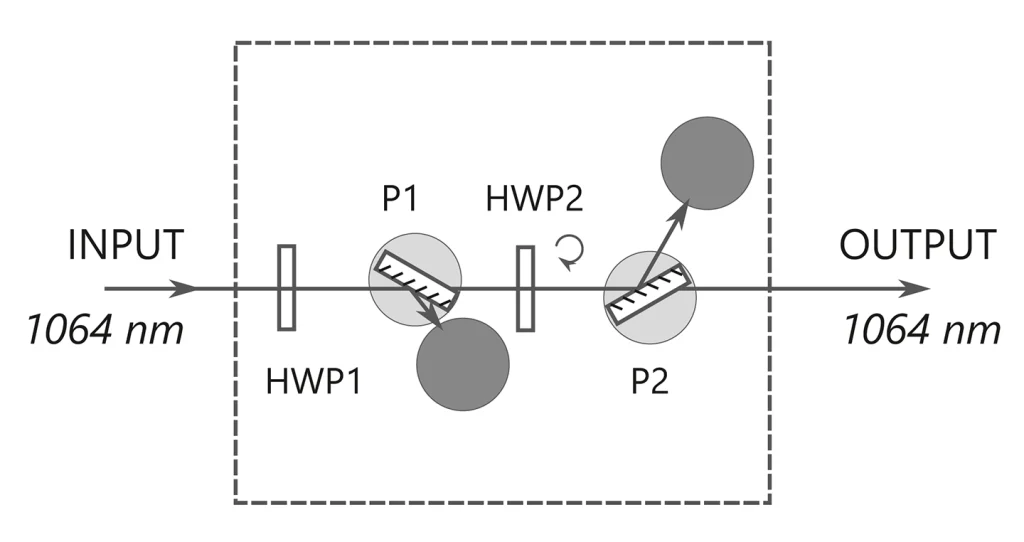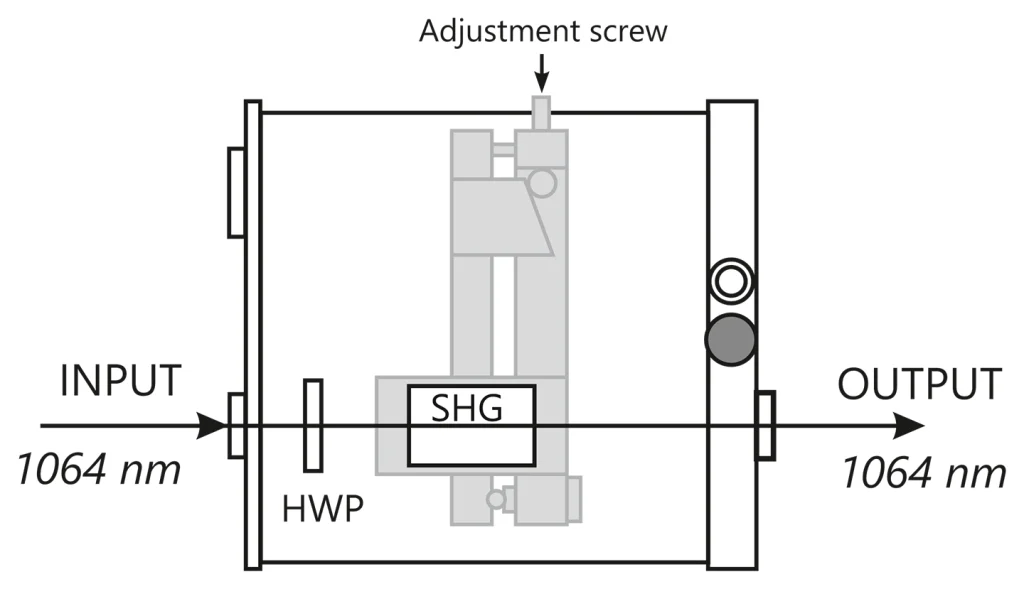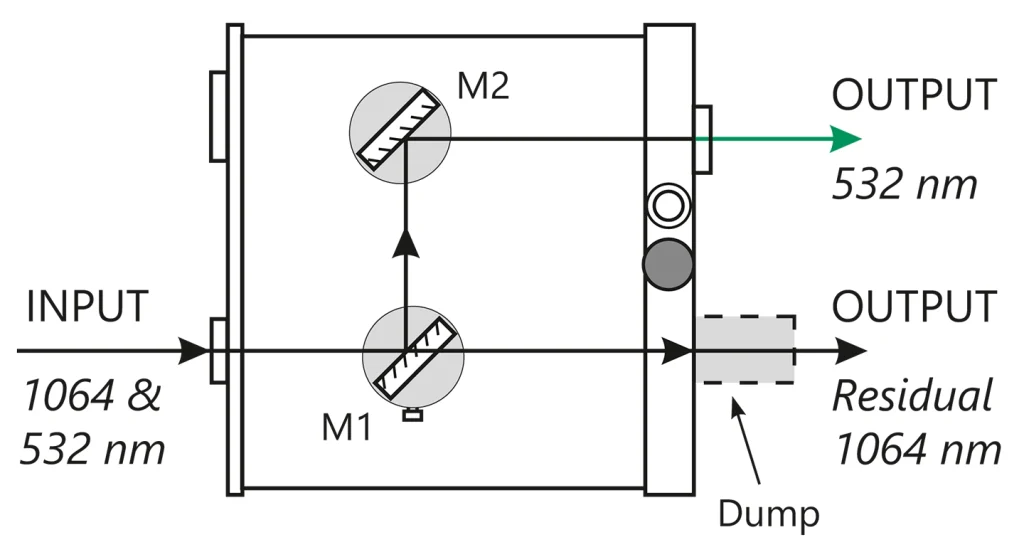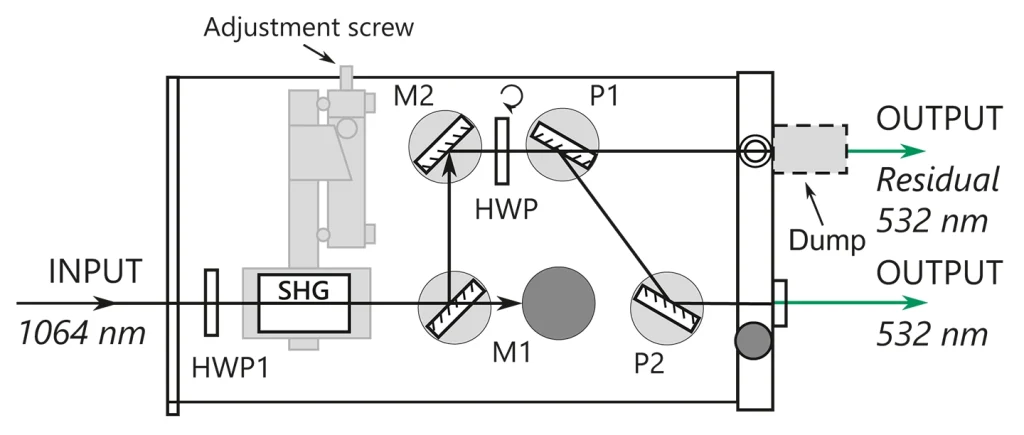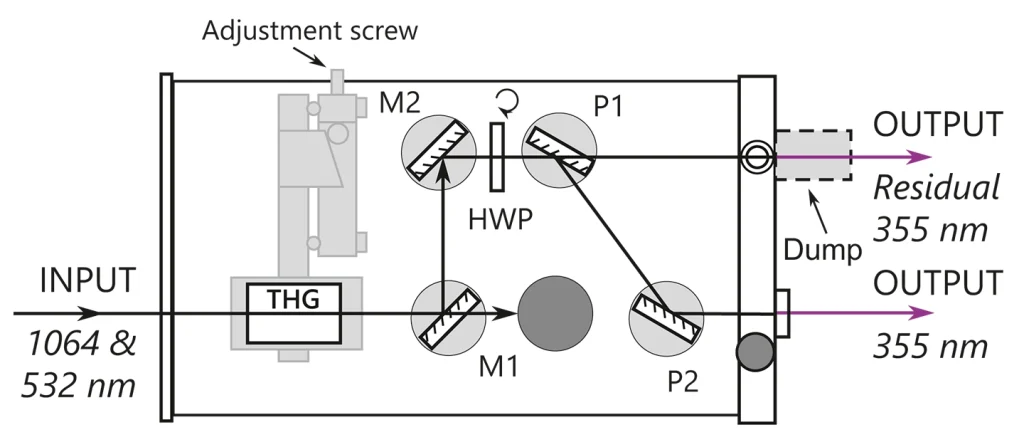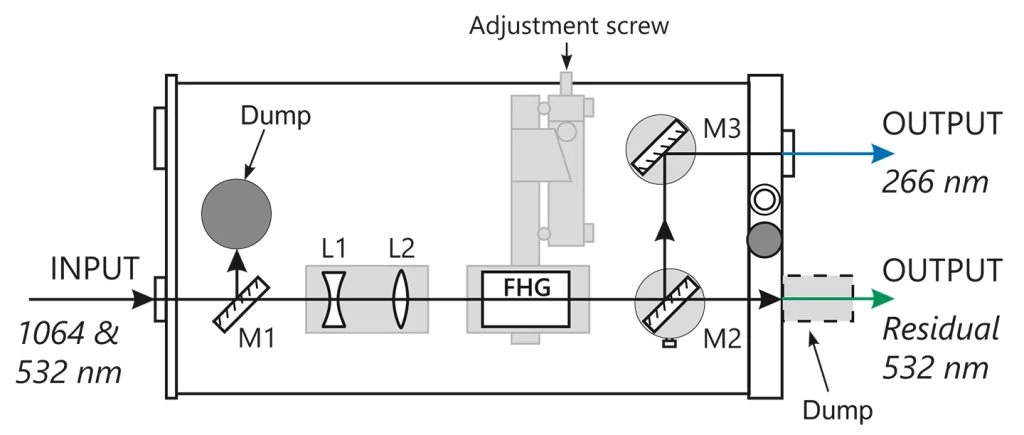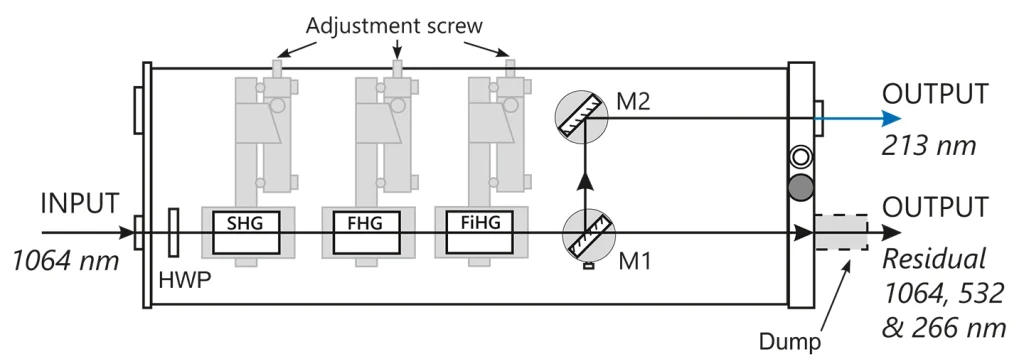NL300 series
Compact Flash-lamp Pumped Q-switched Nd:YAG Lasers
NL300 series electro-optically Q-switched nanosecond Nd:YAG lasers produce high energy pulses with 3 – 6 ns duration at up to 20 Hz repetition rate. A wide range of harmonic generator modules for generation up to a 5th harmonic is available.
Features
- Customers recognized reliability
- Two years warranty
- Rugged sealed laser cavity
- Up to 1100 mJ pulse energy
- Better than 1 % StDev pulse energy stability
- 5 – 20 Hz pulse repetition rate
- 3 – 6 ns pulse duration
- Thermo stabilized second, third, fourth and fifth harmonic generator modules
- Optional attenuators for fundamental and/or harmonic wavelengths
- Water-to-water or water-to-air cooling options
- Replacement of flashlamps without misalignment of laser cavity
- Remote control via keypad and/or RS232/USB port
Applications
- Material ablation
- LIBS (Light Induced Breakdown Spectroscopy)
- OPO pumping
- Remote Sensing
- LIDAR (Light Detection And Ranging)
- Mass Spectroscopy
- LIF (Light Induced Fluorescence)
Description
NL300 series electro-optically Q-switched nanosecond Nd:YAG lasers produce high energy pulses with 3 – 6 ns duration. Pulse repetition rate can be selected in range of 5 – 20 Hz. NL30×HT models are designed for maximum energy extraction from the active element. Up to 1100 mJ pulse energy can be produced at a 5 Hz pulse repetition rate.
A wide range of harmonic generator modules for generation up to a 5th harmonic is available. Harmonic generators can be combined with attenuators that allow smooth output energy adjustment without changing other laser parameters, i.e. pulse duration, pulse-to-pulse stability, divergence or beam profile. For a more detailed description of harmonic and attenuator modules please check our Harmonic Generators Selection Guide.
The extremely compact laser head is approximately 480 mm long and can be fitted into tight spaces. The laser power supply has a 330 × 490 mm footprint. Easy access to the water tank from the back side of the power supply facilitates laser maintenance. Replacement of flashlamp does not require removal of pump chamber from the laser cavity and does not lead to possible misalignment.
The powering unit can be configured with water-to-water or water-to-air heat exchangers. The latter option allows for laser operation without the use of tap water for cooling.
For customer convenience the laser can be controlled via PS with LabView™ drivers (included) or a remote control pad. Both options allow easy control of laser settings.
Benefits
- High pulse energy (up to 1100 mJ at 1064 nm, 700 mJ at 532 nm and 450 mJ at 355 nm) and short pulse duration about 4 ns ensure strong interaction with material which is excellent for LIBS and material ablation applications
- Cost-effective, single-cavity design with no amplifiers for easy alignment, high reliability and low maintenance costs
- Small size saves valuable space in the laboratory room
- Fast flashlamp replacement without realignment of laser cavity ensures easy maintenance
- Air cooling enables simple installation, easy operation and low maintenance costs
- Variety of interfaces: USB, RS232, optional LAN and WLAN ensures easy integration with other equipment
Specifications
| Model | NL303HT-10 | NL303HT-20 | NL305HT-10 | NL305HT-5 |
|---|---|---|---|---|
| Main specifications 1) | ||||
| Pulse repetition rate | 10 Hz | 20 Hz | 10 Hz | 5 Hz |
| Pulse energy | ||||
| at 1064 nm | 800 mJ | 800 mJ | 1000 mJ | 1100 mJ |
| at 532 nm 2) | 400 mJ | 400 mJ | 650 mJ | 700 mJ |
| at 355 nm 3) | 250 mJ | 250 mJ | 400 mJ | 450 mJ |
| at 266 nm 4) | 80 mJ | 60 mJ | 100 mJ | 120 mJ |
| at 213 nm 5) | 13 mJ | 10 mJ | 20 mJ | 25 mJ |
| Pulse energy stability (StdDev) 6) | ||||
| at 1064 nm | 1.0 % | 1.0 % | 1.0 % | 1.0 % |
| at 532 nm | 1.5 % | 1.5 % | 1.5 % | 1.5 % |
| at 355 nm | 3.0 % | 3.0 % | 3.0 % | 3.0 % |
| at 266 nm | 3.5 % | 3.5 % | 3.5 % | 3.5 % |
| at 213 nm | 6.0 % | 6.0 % | 6.0 % | 6.0 % |
| Power drift 7) | ±2 % | ±2 % | ±2 % | ±2 % |
| Pulse duration 8) | 3 – 6 ns | 3 – 6 ns | 3 – 6 ns | 3 – 6 ns |
| Polarization | vertical, >90 % | vertical, >90 % | vertical, >90 % | vertical, >90 % |
| Optical pulse jitter (StdDev) 9) | < 0.5 ns | < 0.5 ns | < 0.5 ns | < 0.5 ns |
| Linewidth | < 1 cm‑1 | < 1 cm‑1 | < 1 cm‑1 | < 1 cm‑1 |
| Beam profile 10) | Hat-Top in near and near Gaussian in far fields | Hat-Top in near and near Gaussian in far fields | Hat-Top in near and near Gaussian in far fields | Hat-Top in near and near Gaussian in far fields |
| Typical beam diameter 11) | ~8 mm | ~8 mm | ~10 mm | ~10 mm |
| Beam divergence 12) | < 0.6 mrad | < 0.6 mrad | < 0.6 mrad | < 0.6 mrad |
| Beam pointing stability (RMS) 13) | 50 µrad | 50 µrad | 50 µrad | 50 µrad |
| Beam height | 68 mm | 68 mm | 68 mm | 68 mm |
| Physical characteristics | ||||
| Laser head size (W × L × H) 14) | 154 × 475 × 128 mm | 154 × 475 × 128 mm | 154 × 475 × 128 mm | 154 × 475 × 128 mm |
| Power supply unit (W × L × H) | 330 × 490 × 585 mm | 330 × 490 × 585 mm | 330 × 490 × 585 mm | 330 × 490 × 585 mm |
| Umbilical length | 2.5 m | 2.5 m | 2.5 m | 2.5 m |
| Operating requirements | ||||
| Water consumption (max 20 °C) 15) | < 8 l/min | < 12 l/min | < 10 l/min | < 6 l/min |
| Ambient temperature | 15 – 30 °C | 15 – 30 °C | 15 – 30 °C | 15 – 30 °C |
| Relative humidity | 20 – 80 % (non-condensing) | 20 – 80 % (non-condensing) | 20 – 80 % (non-condensing) | 20 – 80 % (non-condensing) |
| Power requirements | 208 – 240 V AC, single phase, 50/60 Hz | 208 – 240 V AC, single phase, 50/60 Hz | 208 – 240 V AC, single phase, 50/60 Hz | 208 – 240 V AC, single phase, 50/60 Hz |
| Power consumption | < 1 kVA | < 1.5 kVA | < 1.5 kVA | < 1 kVA |
| Cleanliness of the room | not worse than ISO Class 9 | not worse than ISO Class 9 | not worse than ISO Class 9 | not worse than ISO Class 9 |
| Model | NL303HT-10 | NL303HT-20 | NL305HT-10 | NL305HT-5 |
|---|
- Due to continuous improvement, all specifications are subject to change without notice. The parameters marked typical are not specifications. They are indications of typical performance and will vary with each unit we manufacture. Unless stated otherwise all specifications are measured at 1064 nm and for basic system without options.
- With H300SH, H300S or H300SHC harmonic generator modules. See Harmonic Generators Selection Guide for more detailed information.
- With H300THC harmonic generator modules. See Harmonic Generators Selection Guide for more detailed information.
- With H300SH and H400FHC harmonic generator modules. See Harmonic Generators Selection Guide for more detailed information.
- With H300FiHC harmonic generator module. See Harmonic Generators Selection Guide for more detailed information.
- Averaged from pulses, emitted during 30 sec time interval.
- Measured over 8 hours period after 20 min warm-up when ambient temperature variation is less than ± 2 °C and humidity <± 5%.
- FWHM.
- With respect to SYNC OUT pulse.
- Near field (at the output aperture) TOP HAT fit is >70%.
- Beam diameter is measured at 1064 nm at the 1/e2 level.
- Full angle measured at the 1/e2 level.
- Beam pointing stability is evaluated as movement of the beam centroid in the focal plane of a focusing element.
- See Harmonic Generators Selection Guide for harmonic generators units sizes.
- For water cooled version. Air cooled version does not require tap water for cooling.
- Power requirements should be specified when ordering.
- 110 V AC powering is available, please inquiry for details.
- Required current rating can be calculated by dividing power value by mains voltage value.
Note: Laser must be connected to the mains electricity all the time. If there will be no mains electricity for longer that 1 hour then laser (system) needs warm up for a few hours before switching on.
Options
| Option | Features |
|---|---|
| -AW | Air-cooled power supply option. An adequate air conditioner should be installed in order to keep room temperature stable. |
| Harmonic generator | An extensive selection of harmonic generators up to 5th harmonic. |
| Attenuator | Allow a smooth change of laser pulse energy, while other laser pulse parameters, such as pulse duration, jitter, pulse-to-pulse stability, beam divergence and profile remain the same. |
Harmonic generators & attenuators selection guide
| Module | Description | Output ports | Output pulse energy specifications | Dimensions W×L×H, mm | Extension possible? | Notes |
|---|---|---|---|---|---|---|
| H300A | Attenuator for 1064 nm beam | Port 1: 1064 nm beam | Transmission in 5 – 90% range at 1064 nm | No | Integrated into a laser head | |
| H300SH | Second harmonic generator | Port 1: 1064, 532 nm | n/d | 154×160×128 | Yes | |
| H300S | 532 nm beam separator | Port 1: 532 nm Port 2: residual 1064 nm | See NL300 specifications for 532 nm beam | 154×160×128 | No | Should be used with H300SH |
| H300SHC | Second harmonic generator with 532 nm beam separator | Port 1: 532 nm Port 2: residual 1064 nm | See NL300 specifications for 532 nm beam | 154×210×128 | No | |
| H300SHA | Second harmonic generator, beam separator and attenuator for 532 nm beam | Port 1: 532 nm Port 2: residual 532 nm | Transmission in 5 – 90% range at 532 nm | 154×260×128 | No | |
| H300THC | Third harmonic generator with 355 nm beam separator | Port 1: 355 nm Port 2: residual 1064 & 532 nm | See NL300 specifications for 355 nm beam | 154×210×128 | No | Should be used with H300SH |
| H300THA | Third harmonic generator, beam separator and attenuator for 355 nm beam | Port 1: 355 nm Port 2: residual 355 nm | Transmission in 5 – 90% range at 355 nm | 154×260×128 | No | Should be used with H300SH |
| H300FHC | Fourth harmonic generator with 266 nm beam separator | Port 1: 266 nm Port 2: residual 532 nm | See NL300 specifications for 266 nm beam | 154×260×128 | No | Should be used with H300SH |
| H300FHA | Fourth harmonic generator, beam separator and attenuator for 266 nm beam | Port 1: 266 nm Port 2: residual 266 nm | Transmission in 5 – 75% range at 266 nm | 154×430×128 | No | Should be used with H300SH |
| H300FiHC | Fifth harmonics generator with 213 nm beam separator | Port 1: 213 nm Port 2: residual 1064, 532 & 266 nm | See NL300 specifications for 213 nm beam | 154×350×128 | No |
| Module | Description | Output ports | Output pulse energy specifications | Dimensions W×L×H, mm | Extension possible? | Notes |
|---|
Harmonic generators and attenuators
Features
- Compact harmonic modules
- Thermo stabilized crystals for long lifetime
- Dichroic mirrors
- AR coatings on crystals
- Phase matching by mechanical adjustment
- High conversion efficiency
- Wide selection of different configurations
- Smooth adjustment of output pulse energy with attenuator
Nanosecond Q-switched lasers enable simple and cost effective laser wavelength conversion to shorter wavelengths through harmonic generation. EKSPLA offers a broad selection of wavelength conversion accessories for NL300 series lasers. The purpose of this guide is to help configure available harmonic generator and attenuator modules for NL300 series lasers for optimal performance.
The harmonic module uses a modular design that allows reconfiguration of laser output for the appropriate experiment wavelength. A typical module houses a non‑linear crystal together with a set of dichroic mirrors for separating the harmonic beam from the fundamental wavelength. Nonlinear crystals used for the purpose of wavelength conversion are kept at an elevated temperature in a thermo-stabilized oven.
Two or more modules can be joined together for higher harmonic generation: attaching one extra module to a second harmonic generator allows for the generation of 3rd or 4th harmonic wavelengths. It should be noted that only modules with a single output port can be joined together: it is possible to attach a H300S module to a H300SH unit for 532 nm beam separation, or a H300FHC module for 4th harmonic generation (see detailed description below). Modules with two output ports (e.g., H300SHC) cannot be attached to extra units.
H300A attenuator
The H300A1 module is integrated into the laser head and designed to attenuate a 1064 nm.
Beam (the length of the laser head extends to 619 mm). Optical layout includes half-wave plates HWP1, HWP2 and polarizers P1, P2. Rotation of the HWP2 half-wave plate changes the polarization of the laser beam and its transmission factor via the P2 polarizer.
H300SH harmonic generator
H300SH module contains a SH crystal with a half-wave plate for input polarization adjustment. The output of the H300SH module has both 532 nm and 1064 nm wavelengths.
H300S harmonic separator
The H300S module has two output ports for the separation of 1064 nm and 532 nm wavelengths.
H300SHC harmonic generator
The most cost-effective solution for customers who need a 532 nm wavelength only, the H300 SHC module combines a SHG crystal and beam separators and has two output ports for 532 nm and 1064 nm beams.
H300THC harmonic generator
The H300THC module is a third harmonic generator and beam separator with two output ports for a 355 nm beam, and for a residual 532 nm + 1064 nm beam. This module should be used with the H300SH module.
H300SHA harmonic generator & attenuator
The cost-effective solution for customers who need an attenuated 532 nm wavelength, the H300SHA module combines a SHG generator with attenuator.
H300THA harmonic generator & attenuator
The cost-effective solution for customers who need an attenuated 355 nm wavelength, the H300THA module combines a THG generator with attenuator.
H300FHC harmonic generator
The H300FHC module is a fourth harmonic generator and beam separator for a 266 nm wavelength, with two output ports for a 266 nm beam, and for a residual 532 nm beam. This module should be used with the H300SH module.
H300FiHC harmonic generator
The H300FiHC module is designed to produce a 5th harmonic output. As it requires only a 1064 nm input, the unit contains SH, FH and FiH crystals together with a beam separator for a 213 nm beam.
Publications
Effects of pressure and substrate temperature on the growth of Al-doped ZnO films by pulsed laser deposition
Al-doped ZnO (AZO) thin films were deposited on p-Si (100) by pulsed laser deposition from a composite ceramic target (ZnO:Al2O3) by using 355 nm laser at different O2 background pressure and substrate temperature. Upon ablation at laser fluence of 2 Jcm−2, plasma plume consists of Zn neutrals and ions, Al neutrals and O neutral are formed. As the O2 background pressure increases from 3 Pa to 26 Pa, the energy of the plasma species are moderated. The results show that the ions density and velocity reduced significantly above 13 Pa. The velocity of the ions reduced from 14 kms−1 to 11 kms−1 at 13 Pa, while the ions energy reduced from 63 eV to 42 eV respectively. Below 13 Pa, crystalline and homogeneous AZO nanostructured films were formed. Above 13 Pa, the process results in low crystallinity films with higher porosity. The resistivity of the films also increases from 0.1 ohmcm to 24 ohmcm as the pressure increased. At fixed O2 background pressure of 3 Pa, the adatom mobility of atoms on the substrates is altered by substrate heating. The resistivity of the films decreased to 10–3 ohmcm when the substrates are heated to 100 °C–300 °C during deposition. The films with highest carrier density of 1020 cm−3 and carrier mobility of 13 cmV−1 s−1 are achieved at 200 °C.
Iminothioindoxyl as a molecular photoswitch with 100 nm band separation in the visible range
Light is an exceptional external stimulus for establishing precise control over the properties and functions of chemical and biological systems, which is enabled through the use of molecular photoswitches. Ideal photoswitches are operated with visible light only, show large separation of absorption bands and are functional in various solvents including water, posing an unmet challenge. Here we show a class of fully-visible-light-operated molecular photoswitches, Iminothioindoxyls (ITIs) that meet these requirements. ITIs show a band separation of over 100 nm, isomerize on picosecond time scale and thermally relax on millisecond time scale. Using a combination of advanced spectroscopic and computational techniques, we provide the rationale for the switching behavior of ITIs and the influence of structural modifications and environment, including aqueous solution, on their photochemical properties. This research paves the way for the development of improved photo-controlled systems for a wide variety of applications that require fast responsive functions.
Conversion efficiency of a laser-plasma source based on a Xe jet in the vicinity of a wavelength of 11 nm
We optimized the parameters of a laser-produced plasma source based on a solid-state Nd: YAG laser (λ = 1.06 nm, pulse duration 4 ns, energy per pulse up to 500 mJ, repetition rate 10 Hz, lens focus distance 45 mm, maximum power density of laser radiation in focus 9 × 1011 W/cm2) and a double-stream Xe/He gas jet to obtain a maximum of radiation intensity around 11 nm wavelength. It was shown that the key factor determining the ionization composition of the plasma is the jet density. With the decreased density, the ionization composition shifts toward a smaller degree of ionization, which leads to an increase in emission peak intensity around 11 nm. We attribute the dominant spectral feature centred near 11 nm originating from an unidentified 4d-4f transition array in Xe+10…+13 ions. The exact position of the peak and the bandwidth of the emission line were determined. We measured the dependence of the conversion efficiency of laser energy into an EUV in-band energy with a peak at 10.82 nm from the xenon pressure and the distance between the nozzle and the laser focus. The maximum conversion efficiency (CE) into the spectral band of 10 – 12 nm measured at a distance between the nozzle and the laser beam focus of 0.5 mm was CE = 4.25 ± 0.30%. The conversion efficiencies of the source in-bands of 5 and 12 mirror systems at two wavelengths of 10.8 and 11.2 nm have been evaluated; these efficiencies may be interesting for beyond extreme ultraviolet lithography.
Optical coherence tomography (OCT) with 2 nm axial resolution using a compact laser plasma soft X-ray source
We present optical coherence tomography (OCT) with 2 nm axial resolution using broadband soft X-ray radiation (SXR) from a compact laser plasma light source. The laser plasma was formed by the interaction of nanosecond laser pulses with a gaseous target in a double stream gas puff target approach. The source was optimized for efficient SXR emission from the krypton/helium gas puff target in the 2 to 5 nm spectral range, encompassing the entire “water-window” spectral range from 2.3 nm to 4.4 nm wavelength. The coherence parameters of the SXR radiation allowed for the OCT measurements of a bulk multilayer structure with 10 nm period and 40% bottom layer thickness to period ratio, with an axial resolution of about 2 nm and detect multilayer interfaces up to a depth of about 100 nm. The experimental data are in agreement with OCT simulations performed on ideal multilayer structure. In the paper, detailed information about the source, its optimization, the optical system, OCT measurements and the results are presented and discussed.
Development and characterization of a laser-plasma soft X-ray source for contact microscopy
In this work, we present a compact laser-produced plasma source of X-rays, developed and characterized for application in soft X-ray contact microscopy (SXCM). The source is based on a double stream gas puff target, irradiated with a commercially available Nd:YAG laser, delivering pulses with energy up to 740 mJ and 4 ns pulse duration at 10 Hz repetition rate. The target is formed by pulsed injection of a stream of high-Z gas (argon) into a cloud of low Z-gas (helium) by using an electromagnetic valve with a double nozzle setup. The source is designed to irradiate specimens, both in vacuum and in helium atmosphere with nanosecond pulses of soft X-rays in the ‘‘water-window” spectral range. The source is capable of delivering a photon fluence of about 1.09 x 103 photon/µm2/pulse at a sample placed in vacuum at a distance of about 20 mm downstream the source. It can also deliver a photon fluence of about 9.31 x 102 – photons/µm2/pulse at a sample placed in a helium atmosphere at the same position. The source design and results of the characterization measurements as well as the optimization of the source are presented and discussed. The source was successfully applied in the preliminary experiments on soft X-ray contact microscopy and images of microstructures and biological specimens with ~80 nm half-pitch spatial resolution, obtained in helium atmosphere, are presented.
XUV generation from the interaction of pico- and nanosecond laser pulses with nanostructured targets
Laser-produced plasmas are intense sources of XUV radiation that can be suitable for different applications such as extreme ultraviolet lithography, beyond extreme ultraviolet lithography and water window imaging. In particular, much work has focused on the use of tin plasmas for extreme ultraviolet lithography at 13.5 nm. We have investigated the spectral behavior of the laser produced plasmas formed on closely packed polystyrene microspheres and porous alumina targets covered by a thin tin layer in the spectral region from 2.5 to 16 nm. Nd:YAG lasers delivering pulses of 170 ps (Ekspla SL312P )and 7 ns (Continuum Surelite) duration were focused onto the nanostructured targets coated with tin. The intensity dependence of the recorded spectra was studied; the conversion efficiency (CE) of laser energy into the emission in the 13.5 nm spectral region was estimated. We have observed an increase in CE using high intensity 170 ps Nd:YAG laser pulses as compared with a 7 ns pulse.
EUV spectra from highly charged terbium ions in optically thin and thick plasmas
We have observed extreme ultraviolet (EUV) spectra from terbium (Tb) ions in optically thin and thick plasmas for a comparative study. The experimental spectra are recorded in optically thin, magnetically confined torus plasmas and dense laser-produced plasmas (LPPs). The main feature of the spectra is quasicontinuum emission with a peak around 6.5-6.6 nm, the bandwidth of which is narrower in the torus plasmas than in the LPPs. A comparison between the two types of spectra also suggests strong opacity effects in the LPPs. A comparison with the calculated line strength distributions gives a qualitative interpretation of the observed spectra.
Initiation of vacuum insulator surface high-voltage flashover with electrons produced by laser illumination
In this paper, experiments are described in which cylindrical vacuum insulator samples and samples inclined at 45° relative to the cathode were stressed by microsecond timescale high-voltage pulses and illuminated by focused UV laser beam pulses. In these experiments, we were able to distinguish between flashover initiated by the laser producing only photo-electrons and when plasma is formed. It was shown that flashover is predominantly initiated near the cathode triple junction. Even dense plasma formed near the anode triple junction does not necessarily lead to vacuum surface flashover. The experimental results directly confirm our conjecture that insulator surface breakdown can be avoided by preventing its initiation [J. G. Leopold et al., Phys. Rev. ST Accel. Beams 10, 060401 (2007)] and complement our previous experimental results [J. Z. Gleizer et al., IEEE Trans. Dielectr. Electr. Insul. 21, 2394 (2014) and J. Z. Gleizer et al., J. Appl. Phys. 117, 073301 (2015)].
Enhancement of Laser-Induced Breakdown Spectroscopy (LIBS) Detection Limit Using a Low-Pressure and Short-Pulse Laser-Induced Plasma Process
Laser-induced breakdown spectroscopy (LIBS) technology is an appealing technique compared with many other types of elemental analysis because of the fast response, high sensitivity, real-time, and noncontact features. One of the challenging targets of LIBS is the enhancement of the detection limit. In this study, the detection limit of gas-phase LIBS analysis has been improved by controlling the pressure and laser pulse width. In order to verify this method, low-pressure gas plasma was induced using nanosecond and picosecond lasers. The method was applied to the detection of Hg. The emission intensity ratio of the Hg atom to NO (IHg/ INO) was analyzed to evaluate the LIBS detection limit because the NO emission (interference signal) was formed during the plasma generation and cooling process of N2 and O2 in the air. It was demonstrated that the enhancement of IHg/INO arose by decreasing the pressure to a few kilopascals, and the IHg/INO of the picosecond breakdown was always much higher than that of the nanosecond breakdown at low buffer gas pressure. Enhancement of IHg/INO increased more than 10 times at 700 Pa using picosecond laser with 35 ps pulse width. The detection limit was enhanced to 0.03 ppm (parts per million). We also saw that the spectra from the center and edge parts of plasma showed different features. Comparing the central spectra with the edge spectra, IHg/INO of the edge spectra was higher than that of the central spectra using the picosecond laser breakdown process.
Peculiarity of convergence of shock wave generated by underwater electrical explosion of ring-shaped wire
Nanosecond timescale underwater electrical wire explosions of ring-shaped Cu wires were investigated using a pulsed generator with a current amplitude up to 50 kA. It was shown that this type of wire explosion results in the generation of a toroidal shock wave (SW). Time- and space-resolved optical diagnostics were used to determine azimuthal uniformity of the shock wave front and its velocity. It was found that the shock wave preserves its circular front shape in the range of radii 50 μm<r<5 mm. At r≤15μm, azimuthal irregularities of the SW front were obtained indicating the appearance of azimuthal instability. A surprising finding is that the shock wave propagates with a constant velocity of vsw=1.2M, where M is the Mach number. The dynamics of the leading part of the shock wave, based on the oblique shock wave theory, is presented, explaining the constant velocity of the shock wave.


